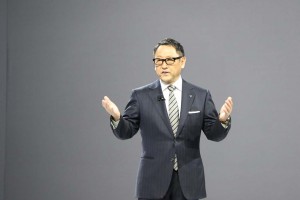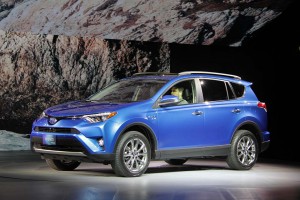A strong yen translated into weaker earnings for Toyota Motor Corp. during the fiscal third quarter, with the impact likely to continue in the months to come, the company anticipating a 26% decline in its net profit for the year ending March 31.
Separately, Toyota officials told reporters that despite comments by CEO Akio Toyoda last month that the automaker will add more jobs in the U.S., there are “no immediate plans” to curb production at Toyota’s factories in Japan which produce about 3 million vehicles annually, many of them bound for America.
Toyota’s earnings could have slipped even further had it not engaged in aggressive cost-cutting, Managing Officer Tetsuya Otake told reporters during a conference call. Nonetheless, the problem will continue, he said, noting, “We’ve revised our full-year yen forecast to 107 yen to the U.S. dollar from 103 yen, which is the biggest contributing factor to our profit forecast revision.”
Toyota saw net profits for the October-December quarter plunge from 627.97 billion yen a year ago to 486.5 billion yen, or $4.3 billion – still one of the best figures for any of the globe’s major automakers.
The company’s revised, full-year forecast anticipates earnings of 1.7 trillion yen, or $15.08 billion, a 26% decline. However, it raised its full-year operating profit 8.8%, to 1.85 trillion yen.

Toyota CEO Akio Toyoda wants to increase jobs in the U.S.- but likely not by shifting production from Japan.
The strong yen isn’t the only challenge for Toyota. The maker is also struggling with a glut of used cars in the North American market which led it to increase its focus on its Certified Pre-Owned vehicle program. CPO sales were up 30% year-over-year. But in many cases, buyers have bought those models in lieu of one of Toyota’s new vehicles, industry analysts note.
(Toyota’s U.S. sales tumble sharply in January. Click Here for more.)
Overall, North American new vehicle sales did rise by a modest 16,000 units, largely driven by “robust” demand for SUVs and pickups, said Otake.
The jump in light truck demand has come at the expense of traditionally strong passenger car models, including the Camry, Corolla and Prius. The hybrid, in particular, has suffered a sharp decline in sales over the past year as fuel prices have remained low. Meanwhile, Toyota officials have said the RAV4 SUV could soon overtake the Camry as the maker’s best-selling model in the U.S.
Toyota has found itself in the middle of America’s political turmoil in recent weeks, President Donald Trump taking aim at the automaker for importing vehicles sold in the States and demanding it increase U.S. jobs. That led CEO Toyoda to last month indicate he would boost employment. But exactly when and where they would come from is unclear.
(Toyota cedes global sales crown to VW. Click Here for more.)
According to Managing Director Otake, Toyota will not curb Japanese production – which accounts for over a quarter of its global output — though that does not appear to rule out shifting home market production to other parts of the world. Separately, Otake also acknowledged that “most of the vehicles” Toyota produces in Mexico are exported to the United States.
Trump has largely focused on exports from Mexico, now one of the world’s five largest automotive manufacturing nation. It could be possible that Toyota will try to satisfy the new president’s demand by curbing production there.
The trade issue is expected to be a centerpoint of conversation at a meeting between Japanese Prime Minister Shinzo Abe and Trump at the White House this week.
(Honda earnings jump sharply during fiscale 3Q. Click Here to learn why.)

